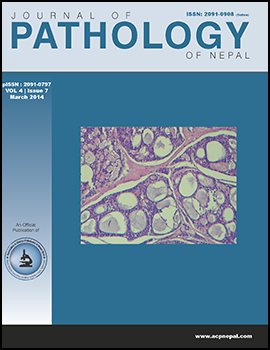Significance of analysing chemical composition of renal stones
DOI:
https://doi.org/10.3126/jpn.v4i7.10314Keywords:
Renal stone, Calcium, Ammonium, DietAbstract
Background: This article aims to decipher chemical composition of renal stones and briefly outline laboratory tests and dietary habitual changes aimed at preventing stone recurrence. It is based on analysis of 95 renal stones received in a private lab in Kathmandu over a period of 1 year.
Materials and Methods: Renal stones were analysed using simple qualitative biochemical tests.The stones were checked for presence of calcium, magnesium, ammonium, oxalate, phosphate, uric acid, cystine and carbonate.
Results: Calcium was present in 97.8%, ammonium was present in 98.9%, phosphate was present in 25.2%, uric acid was present in 17.8%, magnesium was present in 10.5%, carbonate was present in 2.1% and cystine was not present in any of the stones. Most of the stones were composed of mixture of two or more than two of the above mentioned elements.
Conclusion: Most stones are mixture of more than two cations and anions. Studies on larger test samples and if possible in correlation with routine examination of urine and urinary electrolyte excretion in a 24 hr urine sample would further aid in efforts aimed at preventing stone recurrence.
DOI: http://dx.doi.org/10.3126/jpn.v4i7.10314
Journal of Pathology of Nepal (2014) Vol. 4, 560-564
Downloads
Downloads
Published
How to Cite
Issue
Section
License
This license enables reusers to distribute, remix, adapt, and build upon the material in any medium or format, so long as attribution is given to the creator. The license allows for commercial use.




